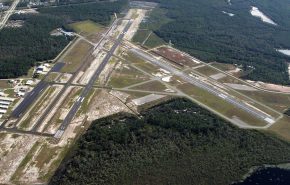Airport officials look for creative ways to partner with the private sector to stay competitive
In 1939, Franklin D. Roosevelt proclaimed that Orville Wright’s birthday, August 19, would be honored as National Aviation Day–offering an opportunity to reflect and celebrate achievements in aviation. Since Orville’s first flight more than 100 years ago, aviation advancements and their impact on the global society have been tremendous. Today, there are nearly 87,000 flights in the United States skies at any given time, and this growth trend is predicted to continue. The 2014 FAA forecast calls for U.S. carrier passenger growth to average 2.2 percent per year over the next 20 years.
Airports today are focused on innovative planning strategies, practical design concepts, and available funding opportunities to support this continued growth, keep operations running smoothly, and make money. A national trend in the commercial real estate industry is focusing on capitalizing on the economic development around airports—providing revenue for airport authorities, as well as an opportunity for private investors to maximize resources.
Through 30+ years’ experience working with airport clients such as Panama City-Bay County Airport District, Greater Orlando Aviation Authority (GOAA), and Sebring Airport Authority, Senior Director Owen Beitsch, PhD, FAICP, CRE recognizes the importance of looking at traditional airport uses to determine if structures and businesses can generate non-aviation revenues while helping to grow the local economy. “Airports today are serving as an anchor to development. Access to highways leading to the airport, concessions, rental cars, and lodging are all things we have to consider for a well-thought-out aviation hub. Finding revenue sources to fund these projects can be difficult, so airports need to evaluate alternative opportunities to increase access to private capital. A particular advantage to using other funding sources is that the income produced is less restrictive and controlled than the proceeds attained from traditional aviation applications.”
One example of strategic planning and partnering success is GOAA’s 15,000-acre international airport complex. GOAA conducted studies to address the best use options of certain lands and develop implementation strategies for strategic infrastructure investments. Choosing this analytical approach was critical for GOAA to complete its plans and projects.
Partnerships between airports and private developers utilize private funding resources to leverage airport infrastructure, operations, and maintenance challenges. Using tools such as strategic planning, growth analysis, capital and operational budgeting, financial planning and management, and incentive strategies, Owen has advised a number of organizations on managing strategic and analytical problems.
As we move into the future, there is no telling how we will improve on the invention of human flight in 1903. But we do realize we will always need to find innovative and cost-effective ways to manage the facilities that hold people and move airplanes. Finding the resources, navigating the funding processes, and analyzing non-aviation revenue will be imperative for airport owners.
For more information on how GAI can assist with navigating airport funding programs, regulatory pressures, and development trends, contact Senior Director Owen Beitsch, PhD, FAICP, CRE at 407.423.8398.


